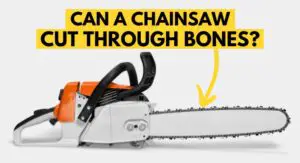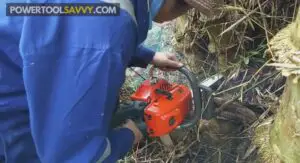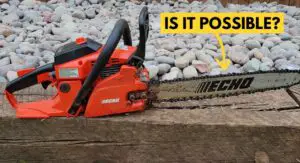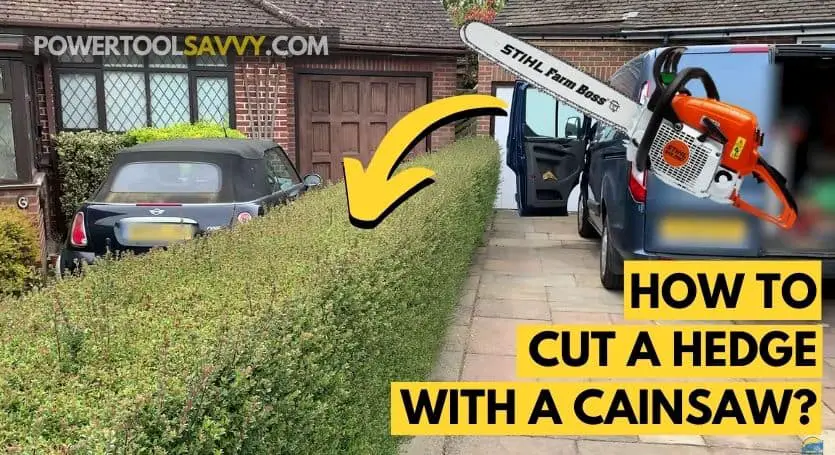
When it comes to trimming hedges, we’ve got a bunch of options, but let’s be real, chainsaws can be pretty tempting.
(I mean, who can resist that urge, right? 😌)
But you definitely gotta have some serious SKILL and play it super cautious if you’re gonna use a chainsaw for this kind of gig.
No room for messing around here! 🙅♂️😬
Don’t worry!
I’m Samuel Anali and I have 20+ years of chainsawing experience. In this article – I’ll show you how to use a chainsaw to cut your hedge, SAFELY!
So, are you READY??
Let’s get started!
Table of Contents
ToggleStep-By-Step Process to Cut a Hedge with a Chainsaw?
Here’s a step-by-step guide to cutting a hedge with a chainsaw: 👇
Step 1: Wear Your Safety Gear
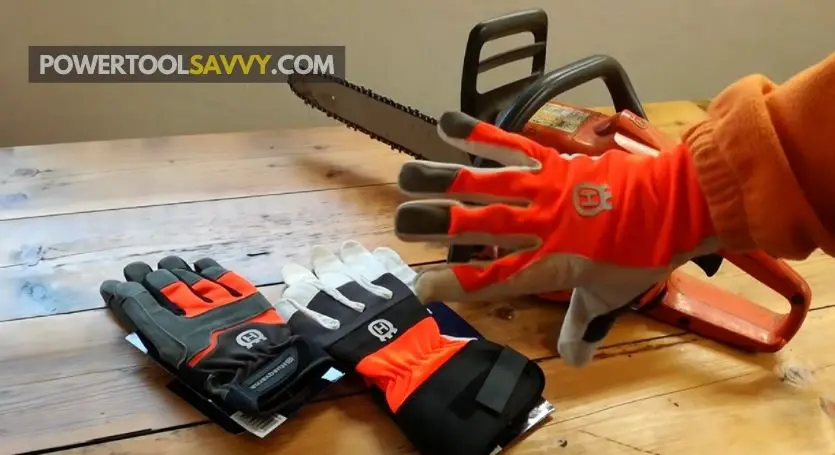
I know you’ve heard it a million times, but it’s worth repeating:
“Always wear the proper SAFETY gear when using a chainsaw!“
This includes – 👇
- Safety glasses 🥽,
- Ear protection 🎧, and
- Heavy-duty work gloves 🧤.
These are MUST-HAVES before even considering firing up that chainsaw.
(I would also recommend wearing long pants, a long-sleeved shirt, and sturdy boots or shoes!)
Step 2: Prepare the Hedge
Before firing up your chainsaw, take a few minutes to prep the hedge!
Cut out the thick branches from the hedge first. I prefer using small hedge shears or hand pruners for this JOB!
When you’re done, clear away any plastics, mulch, rocks, and debris to ensure a clean working surface.
Step 3: Start Your Saw and Hold it Firmly
Pull the starter cord and get your saw running. (Nothing fancy here!)
Once the saw is running, GRIP on the saw with both hands.
- If you’re right-handed, place your left hand on the front handle and your right hand on the rear handle.
- If you’re left-handed (like me!), do the opposite. Place your right hand on the front handle and your left hand on the rear handle.
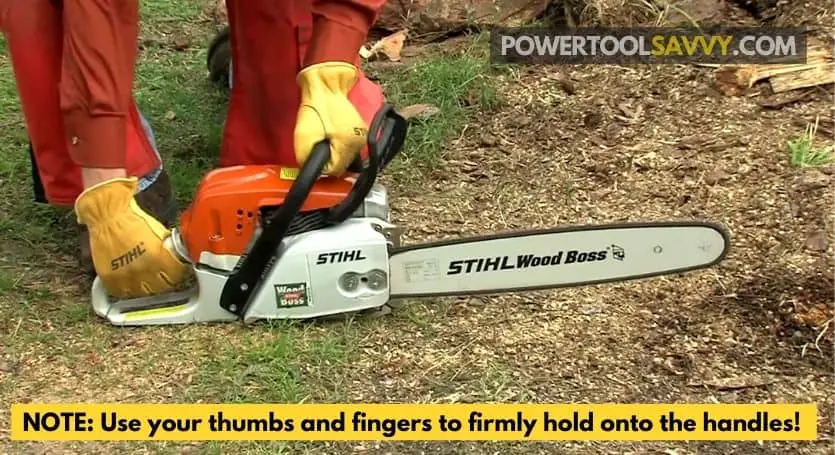
Step 4: Start Cutting
Here’s the HARD step!
Well this step is divided into 2 parts:
Vertical Cut:
- Pull the throttle trigger to accelerate the engine.
- Tilt your saw slightly (about 15°) and start cutting.
- Make sure to move it real SLOW as you go upwards. Give it a few swings to cut through the whole hedge. No need to rush this!
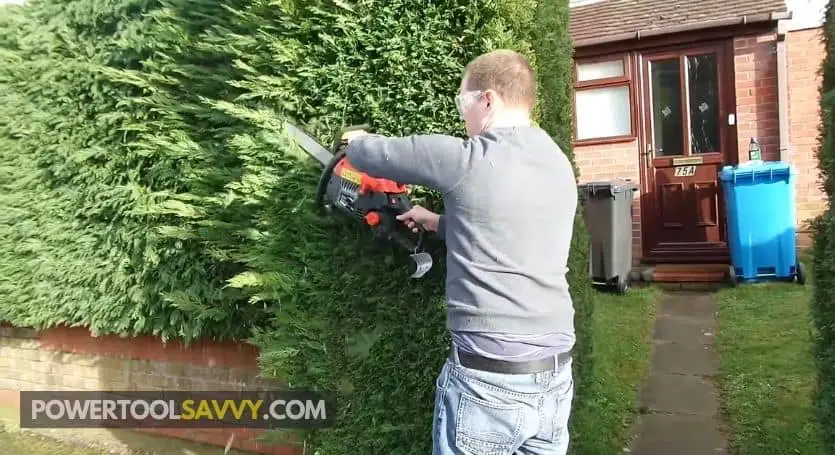
PRO-TIP: Your Hedges Should Be Narrower at the Top Than at the Bottom (Like a Pyramid!)
Here’s why: 👇
When hedges are left untrimmed for a while, they tend to spread out up top. It’s because the upper section soaks up more sunlight and grows faster than the lower part.
So, when you’re doing your hedge trimmin’, aim to keep the top a tad slimmer than the bottom. It’s all about that even growth, my friend! ☀️🌿✂️
Horizontal Cut:
- Pull the throttle trigger to accelerate the engine.
- Tilt your saw horizontally so the bar is perpendicular to the ground.
- Then, start swaying that saw from side to side to make sure you’re getting that cut nice and even.
PRO-TIP: A slight 5-10° tilt of the blade toward the cutting direction often helps produce a cleaner cut.
Step 5: Inspect The Hedge
Once you’re DONE with the cutting part, take a little step back and give your work the once-over!
Check for any spots where things might look a bit wonky or if there are gaps in the hedge.
If you spot any of those, don’t sweat it!
Grab your trusty hedge shears (my personal GO-TO for hedge trimming!) and tidy things up real nice.
It’s all about that finishing touch! 👍🌳✂️
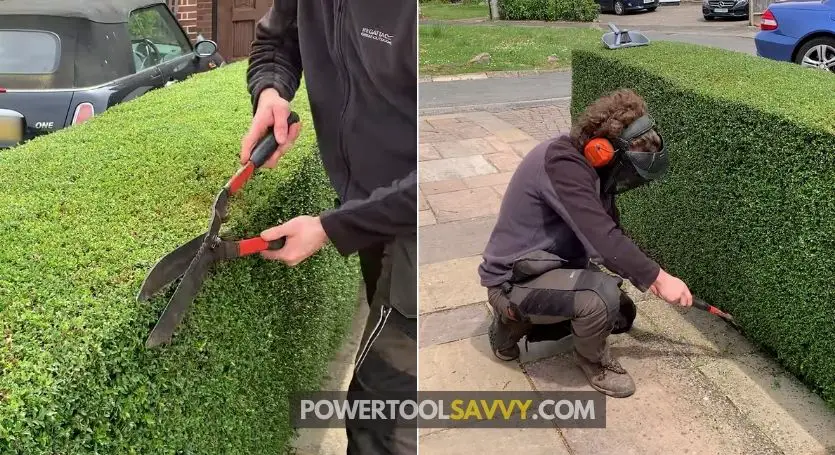
Step 6: Clean Up
When you’re HAPPY with the result, turn off the saw, and allow it to COOL down before you do any cleaning.
Grab a brush or cloth and clear away any junk like debris and sawdust that’s hanging around on the saw. You might have to take off the bar cover for this part!
And when you’re done, find a NICE, DRY spot to stow it until the next time you’re ready to unleash it on those hedges.
Easy-peasy! 😃🧹🌞
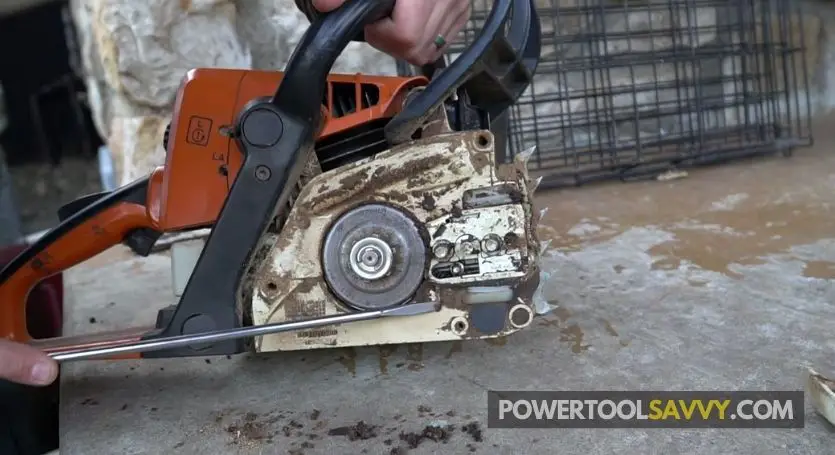
Using a Hedge Trimming Attachment for Chainsaw
A hedge-trimming attachment is a versatile tool that enhances the functionality of your saw for hedge maintenance.
The best thing?
This attachment comprises a specialized bar equipped with a series of blades, which literally turns your saw into a dedicated hedge trimmer.
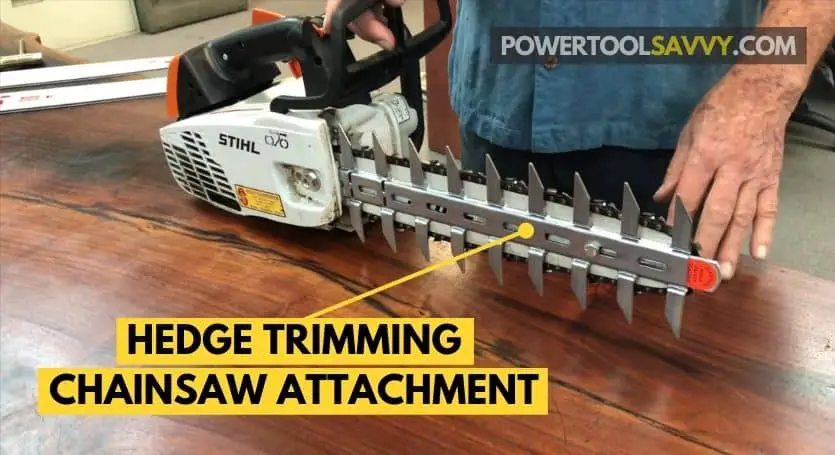
But what’s the point of using this attachment??
See, chainsaws aren’t really cut out for delicate tasks like hedge trimming or snipping small branches.
If you try to PUSH your bare saw against a hedge, you’ll notice those branches whipping all over the place, and you won’t get a clean cut.
Plus, you RISK damaging the hedge, your saw, and yourself!
And that’s where a hedge trimming attachment shines: 👇
It grabs onto those little twigs, leaves, and branches, holding them steady while your saw’s chain does its thing! (How cool is that?)
And those blades on it make sure you don’t go too deep, ensuring a smooth and clean trim job, while keeping your saw safe from any unexpected ground bumps.
Here’s what one of our Reddit community members had to say: 👇
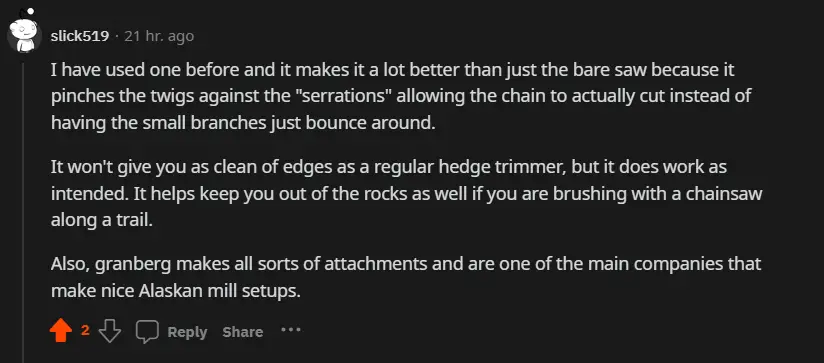
Wait! wait!
Don’t set your expectations too high!
From my own experience, the attachment tends to get a bit wonky if you’re dealing with branches thicker than 1″. (but pencil-size branches? piece of cake!)
I’ve got a Stihl MS192T with an old-style hedge trimming attachment. I mostly use it for pruning fruit and ornamental trees!
However, these attachments usually won’t break the bank, costing you under $30 (a far cry from the $100+ you’d shell out for a hedge trimmer).
And If I’m not WRONG, only Granberg sells them at the moment. (Check them out here!)
Got one already??
Then here’s how to attach it to your chainsaw: 👇
What Size Chainsaws are Ideal for Cutting Hedges?
If you’re dealing with smaller hedges, aim for a 12″ to 14″ chainsaw. But for those bigger hedges, you’ll want to go for a 16″ to 18″ chainsaw.
You won’t require an extremely powerful saw for this job.
I’d recommend sticking with a smaller to medium-sized saw. They strike a nice balance between power and weight.
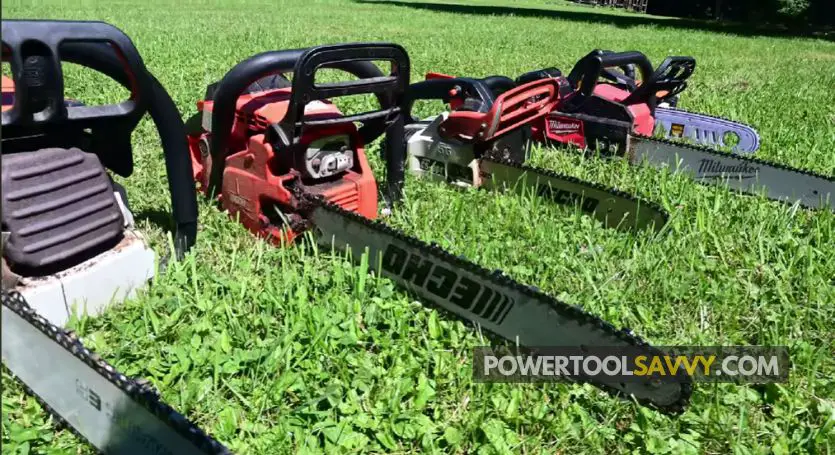
The saw I use dedicatedly for pruning tasks (Stihl MS192T) packs 30cc of power and weighs around 3kg. It’s been a champ for me all along!
Oh, and a word of advice:
Don’t go beyond an 18-inch bar when you’re tackling those hedges. Anything longer can get unwieldy and a pain to handle in tight spots.
Also, hedge trimming attachments are mainly designed with 12″, 14″, 16″, and 18″ bars in mind.
Is It SAFE to Use a Chainsaw for Cutting Hedges? (Don't SKIP!)
Here’s what you need to know: 👇
Chainsaws are designed to cut large trees and thick logs, not the thin, leafy branches you find on a hedge.
I’ve witnessed those tiny branches and twigs catch the chain and pop it right off the bar!
Here’s what one of our Reddit community members had to say: 👇

On top of that, it’s quite HARD to achieve those precise cuts necessary for a well-manicured hedge with a chainsaw.
The first time I tried trimming a hedge with my saw, I ended up with a mess of uneven cuts. (and not to mention, I nearly lost my fingers!)
That’s not all!
Hedge trimming takes a lot of time – a few hours or sometimes even a full day to finish the job.
Plus, it involves standing on ladders or scaffolding (often in awkward positions!) and holding the saw with two hands (while peering up at a hedge that’s taller than yourself!).
Just imagine the neck, back, and shoulder strain that comes with using a chainsaw for such work.
Definitely not a good idea!
Best Tools for Cutting Hedges
Here are 3 tools that I found to be the best for cutting hedges: 👇
1. Hedge Trimmers
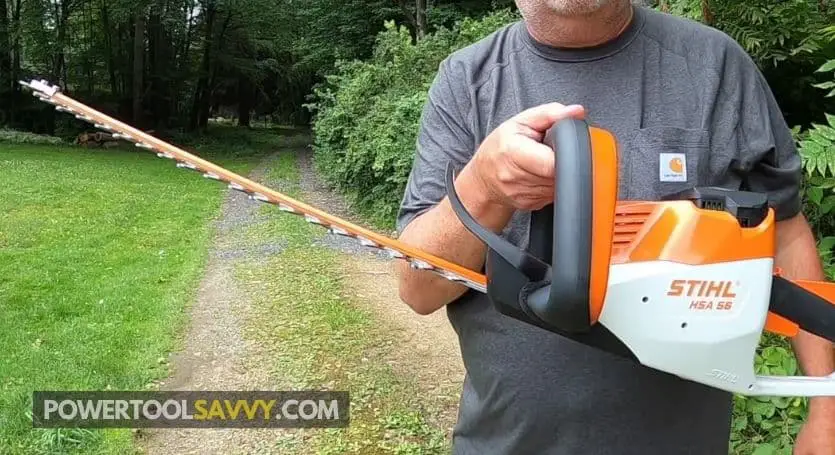
Both electric and gas-powered hedge trimmers are perfect for this job. They come in all sorts of sizes, from the handheld champs to those long-reach heroes.
I personally like the electric ones. They’re quieter, lighter, and easier to maintain.
I had a Stihl HSA 56, but I had to say goodbye to it just last month. It was a good run!
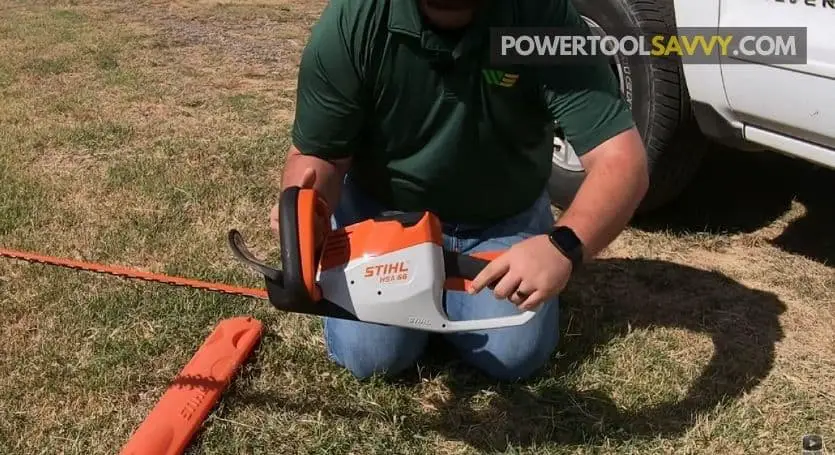
2. Hedge Shears
Ah, hedge shears – a classic tool for avid gardeners!
These manual tools may seem old-fashioned in this age of electric hedge trimmers, but there’s a certain SATISFACTION that comes with using them.
The satisfying “snip” sound, the precision of the cut, and the simplicity of the design – all add up to a gardening experience that’s hard to beat.
Plus, they’re lightweight, easy to use, and the best part? No power source is required. Just a little elbow grease and some muscle! 💪🌳✂️
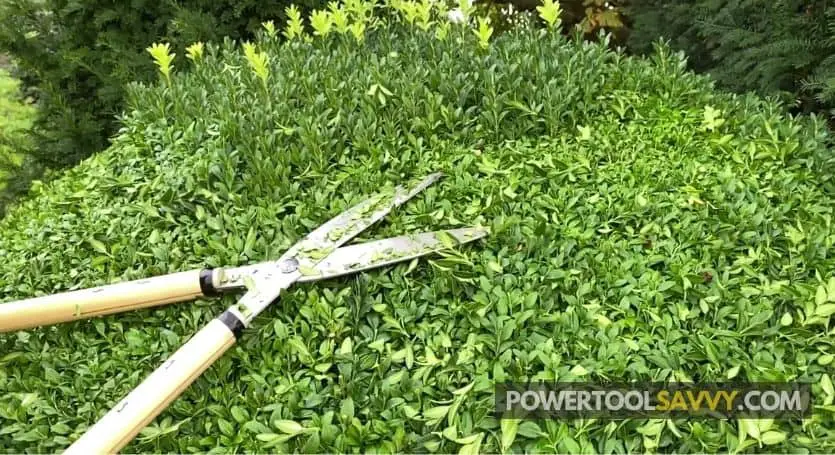
Hedge shears aren’t very expensive. You can snag a solid pair for less than 20$, and they’ll serve you well!
Since I no longer have a hedge trimmer, I’ve been relying on my hedge shears.
3. Loppers
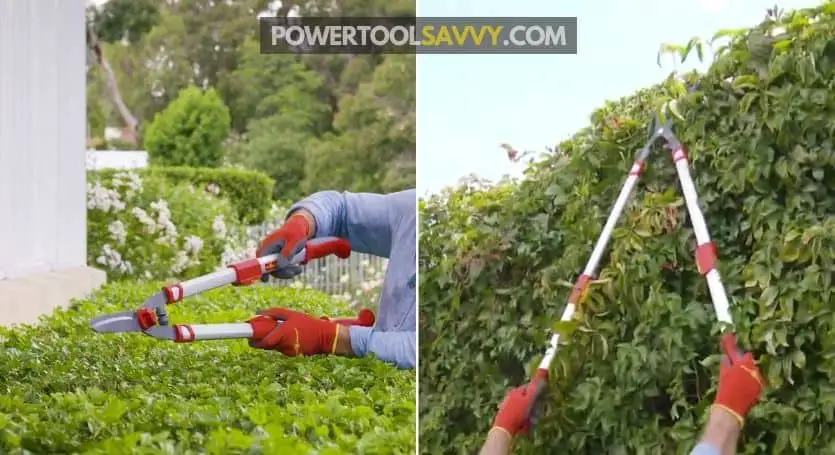
Loppers are quite similar to hedge shears, but they’re bigger and heavier. (perfect for tackling bigger hedges!)
They come in different sizes and lengths and are available with different cutting mechanisms (anvil or bypass).
Loppers with decent build quality typically fall within the price range of $20 to $50.
GoodBye Words!
And there you have it!
I’ve tried my BEST to dish out all the info you’ll need before you dive in.
But hey, if you’re still scratching your head or have any burning questions, don’t hesitate to drop a comment below.
Keep it safe out there as you work on those hedges! 🌳🪚✂️😊

